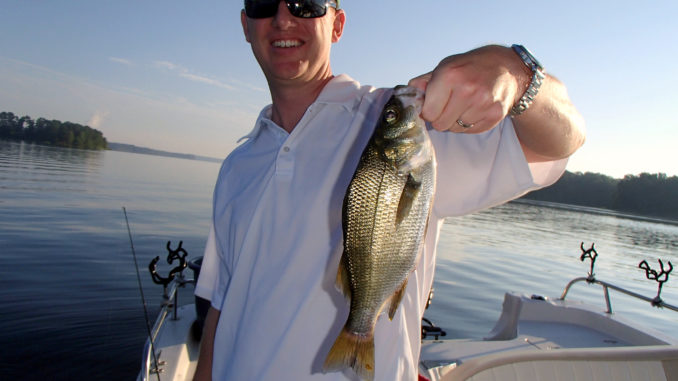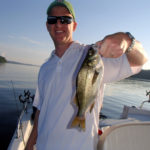
Biologist says white perch population is peaking at Shearon Harris Lake
It’s no secret that Shearon Harris Lake between Raleigh and Sanford is a hot spot for trophy bass and slab crappie. But another species has taken up residence in the prime liquid real estate, as anglers are collecting a rising number of white perch. Although their presence has been met with mixed emotion, one thing is for certain, they are delicious.
“Our best guess is that they were put here by a well-intentioned fisherman,” said biologist Kirk Rundle of the N.C. Wildlife Resources Commission. “We first started seeing them in early 2000, but we’ve seen a lot of growth in the species since 2010. The population is at its peak now.”
White perch are not actually a member of the perch family; they belong to the moronidae family that includes striped and white bass. They are native to the Atlantic coast, where they prefer low-salinity estuarie, including coastal rivers. The Albemarle and Pamlico sounds and their tributaries are their natural waters in North Carolina, and their abundance in many of our reservoirs is due strictly to introduction, which Rundle points out is highly illegal.
While many anglers lament their appearance, due to the perch’s tendency to out-compete other, more-desirable species, Greg Griffin of Greggofish Guide Service is taking these swimming lemons and making lemonade.
“If I’m having a slow day catching largemouth or crappie, I’ll fill up my client’s cooler with white perch,” Griffin said. “Most people don’t know about this fishery at Harris, but it’s probably one of the best in the state.”
Perch are prolific at Harris, and they tend to run on the heavy side thanks to a healthy forage base. Griffin (919-434-4183) often tangles with white perch in the 2-pound class, and he has flirted with the state record of 2 pounds, 15 ounces, caught from Falls of the Neuse Lake in 2001. That fish is just two ounces short of the world record.
“I catch the biggest perch in June, but you can catch them practically year-round,” he said. “In the summer, the best bite is from around 7 to 8:30 or so in the morning.”
Griffin believes this is when perch are schooled up tight and on the feed, although he scores good numbers throughout the day.
“In the winter, they drop down to about 30 feet and hang with the crappie I’m trying to catch,” he said.
Griffin’s specialty is catching largemouth bass with threadfin shad about 4 inches long. But if he pulls up on one of his bass spots and finds it infested with perch, he capitalizes on the opportunity by scaling down to juvenile threadfins that only measure around 2 inches.
“I find the smaller shad in the shallow coves and run the trolling motor with my cast net ready until I see them,” said Griffin, who uses a cast net with quarter-inch mesh. “This time of year, the banks are loaded with juveniles.”
Griffin keeps his shad in a well-aerated, 50-gallon livewell.
“Shad have to be able to swim to stay alive; they need a lot of room. Minnows will work, and they’re easier to keep, but they prefer their natural forage. Using larger shad as cut bait will also catch a big perch,” he said.
While Griffin prefers live bait, there are artificial alternatives.
“A small Hopkins spoon jigged off the bottom or cast into the school will produce,” said Griffin, whose other recommendations include crappie jigs and small crankbaits.
Griffin’s main setup consists of a Carolina rig with a 1/4-ounce egg sinker and a No. 4 long-shank panfish hook.
“Perch are swallowers; I like to use that long hook so I have something to grab for unhooking,” said Griffin, who has found perch to be most predictable when on the bottom. However, if they are suspended, an adjustable slip float will allow Griffin to dial in on their depth.
“White perch like the same long points as the bass I’m targeting,” said Griffin. “In fact, the biggest perch will often school with bass and crappie.”
The main-lake points near the boat ramps at Holleman’s Crossing are his primary focus.
“They usually hang out in 12 to 15 feet of water and do not go shallow nearly as often as their smaller counterparts,” he said “When I’m on a bass charter, I may have to jump around to stay away from them. But if I have kids in the boat, they’re in for steady action when we find perch. They are actually great fighters. Pound for pound, they’re as strong as any fish that swims.”
Many of Griffins clients will request to fill a cooler to take home. While there are no size or creel limits on crappie or channel catfish in Harris, white perch are the top choice for filling that cooler.
“I actually prefer eating white perch over crappie. It’s the best tasting fish in the lake, and we caught over a hundred this morning,” he said.
The white perch’s abundant numbers relate directly to its spawning habits.
“They are broadcast spawners with adhesive eggs,” said Rundle. “White perch release eggs over a large area, as opposed to many species that leave piles of eggs that are easily detected by predators. Furthermore, white perch eggs stick to everything, greatly increasing their hatchability.
“In the Albemarle and Pamlico Sounds where they are native, they make a short spawning run up the tributary rivers. Sometimes they stop to spawn in the mouths of those rivers,” said Rundle.
This technically makes them a semi-anadromous species, meaning they live in brackish water and spawn in freshwater. However, their eggs do not need to drift or tumble like a striper, Rundle said. This makes spawning in a man-made impoundment successful, maybe too successful.
White perch get a bad rap due to their propensity to overpopulate and out-compete more desirable species. But at the moment, bass and crappie appear to be holding their own in Harris.
“There is no downturn in the population of bass or crappie. We’re doing individual net surveys every two years for each species, on alternating years,” said Rundle. “The catch rates are great.”
However, their voracious appetite for baitfish is not the only issue.
“They are a known egg eater,” said Rundle.
Proven to devour the eggs of walleye and white bass, there is possibility they could do the same to Harris’ prized lunker stock.
“They do have the potential to be a problem,” he said.
Griffin has also noticed the spiking perch levels in the past several years and expresses his concern.
“I fish Harris almost every day, and I’m catching a lot more perch than I used too,” said Griffin, who believes a heavy shad population has allowed the perch numbers to increase without harm to the bass or crappie reserves.
“The past three winters haven’t produced a noticeable shad kill. When we have a shad kill, which is normal, I’m afraid the perch are going to dominate the remaining baitfish,” he said, pointing out that white perch are aggressive feeders, often following a hooked fish to the surface in packs. They are extremely competitive.”
Only time will tell what is in store for the future of Shearon Harris, but it appears white perch will be a part of it. According to Rundle, they are here to stay, and for the time being, the lake is as healthy as ever and there has never been a better time to have a fish fry.
DESTINATION INFORMATION
HOW TO GET THERE/WHEN TO GO — Located just of US 1 between Raleigh and Sanford, Shearon Harris Lake is accessed from two public boat ramps: Cross Point Landing on the lower end of the lake off NC 42, and Holleman’s Crossing off US 1 and Bartley-Holleman Road. Perch can be found on main-lake points for most of the summer, coinciding with the schooling bass activity. They are catchable through the fall, residing in deep water in the winter.
TACKLE/TECHNIQUES — Light- to medium-action rods are good choices for white perch. A reel spooled with at least 8-pound monofilament is recommended in case a largemouth bass or channel catfish takes a bait. Standard rigging is a Carolina rig, 1/4-ounce egg sinker and No. 4J-hook. Live juvenile threadfin shad are tops for bait, but minnows will work. A small Hopkins spoon is an option if bait is unavailable.
GUIDES/FISHING INFO — Greg Griffin, Greggofish Guide Service, 919-434-4183, www.greggofish.com. See also Guides and Charters in Classifieds.
ACCOMMODATIONS — Hampton Inn and Suites, Holly Springs, 800-230-4134; Comfort Inn, Apex, 800-997-5148; Holiday Inn Express, Apex, 800-997-5149.
MAPS — Fishing Hot Spots Maps, 1-800-ALL-MAPS, www.fishinghotspots.com; Delorme North Carolina Atlas and Gazetteer, 207-846-7000, www.delorme.com.








